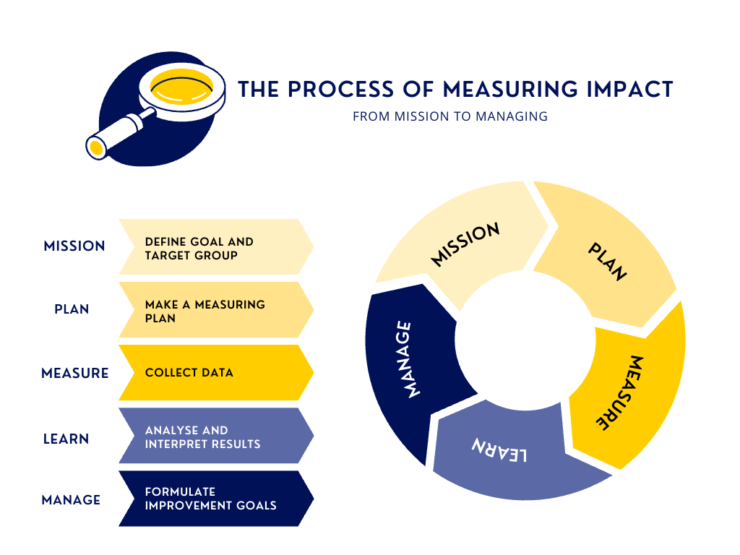What is measuring impact?

Measuring impact is a way to evaluate science communication. It allows you to map the effects of your scicom project. It answers the questions: who did I reach and has something changed in these people?
Our knowledge clip tells you more about science communication, our question bank and gives a couple of practical examples (English subtitles available):
(You can find all the terms we use in this video in our jargon buster!)
How do you start measuring impact?
The process model below gives you an overview of the steps you can take while measuring impact. In theory, you could start at any step in the model. For the sake of convenience, we start our explanation at mission.

Mission
Make an overview by deciding:
- What do I want to achieve? (Goal)
- Whom do I want to reach? (Target audience)
You can use the answers to these questions to determine what you want to measure. Ask yourself:
- What needs to change in my target group in order for my project to be successful?
- How can I measure this change?
Example: you want to teach (goal) primary school children (target group) something about sustainability using an interactive teaching module. For your project to be successful, something needs to change in the knowledge of your target group. A change in knowledge could for instance be measured by a knowledge quiz, which you can organise before and after your teaching module.
There are a couple of specific changes that you can aim for in your target audience, also known as communication goals. These communication goals can be divided into knowledge (teaching your target audience something new), attitude (changing the way your target audience thinks) and behaviour (changing the way your target audience acts). When measuring impact, try to pick one goal to focus on: this keeps your measurement feasible!
Measuring plan
Do you have in mind whom you want to reach, what you want to achieve and which changes you need to measure? Developing your impact measurement is the next step. Make final choices about what you want to measure and think about the design of your measurement. You could for instance go for a questionnaire, but there are many other ways to measure impact. Take a look at our tools if you need some help deciding which instruments to use.
Measuring
Once you have finalised your plans, you can start putting them to practice. You can use the moment of data collection to check how your target group responds to your measurement. You might find out that your chosen method wasn’t a good fit for your target audience or setting after all, which can impact the number of responses you will be able to collect. Be observant and ask your target audience for feedback if possible.
Example: a questionnaire is often a good and practical choice to measure impact, but it is not the best choice for specific target audiences and settings. For instance, young adults at a music festival will not easily be persuaded to take part in your measurement if it entails a five-page questionnaire.
Learning
This step is about analysing the data which you collected in the previous step. Whom did you reach, did anything change in your audience and which lessons can you learn? We are currently developing step-by-step guides on how to analyse and report the results of your impact measurement. To be continued!
Managing
Measuring impact is not a linear process, but something you can do continuously. The results of your impact measurement can be used to formulate goals that will improve your next scicom project.
Example: was it your goal to engage people outside of academia, but did you primarily reach students and scientists? “Reaching more people outside of academia” would be a good goal for the next edition of your scicom activity.
Realise that your scicom activity and impact measurement do not have to be perfect from the first try. Some lessons can only be learned in practice. Approach your first scicom activity and impact measurement as a pilot, to test which things do and do not work. By measuring continually and using the results of your measurement to improve your project, you will be able to reach your goals and target groups to a bigger and bigger extent. And that means more impact!

